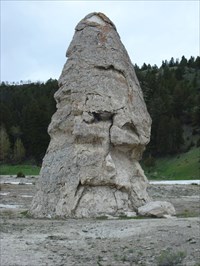
Visitors to Yellowstone National Park's Mammoth Hot Springs typically ooh and ahh as they stroll the trails leading through and around the geothermal terraces for which this area is named. Tiered like wedding cakes with fluted edges sculpted by nature, the travertine terraces of Mammoth Hot Springs are a breathtaking example of the park's geothermal activity.
So what is this tall, oddly shaped object near the Lower Terraces that sticks out like a sore thumb?
This natural structure is known as the Liberty Cap. Named in 1871 by the Hayden Survey Party, Liberty Cap was so dubbed because of its resemblance to the peaked hats worn during the French Revolution. While Liberty Cap appears to be some sort of sculpted stone, it in fact was at one time a hot spring, just like the features nearby.
To receive logging approval for this Earthcache, please email us the following information:
1. TWO PARTS. 1a. Contrast the shape, size, and structure of Liberty Cap to the shape, size, and structure of the Lower Terraces. PLEASE DO NOT DESCRIBE THE LOWER TERRACES AS TERRACES, OR TERRACED, OR TERRACE-LIKE! Be descriptive! Be imaginative! Pretend that you are traveling with a blind companion and are painting a verbal picture for your friend. We are VERY much into the verbal descriptions of the Cap and Terraces, so don't sell yourself short by just using two or three words for each... we'll ask you to try again. 1b. Next, how do the Cap and the Terraces differ from each other in their formation (how they were formed)? What caused this difference?
2. THREE PARTS. 2a. Compare the color of Liberty Cap to the colors visible in the Lower Terraces. What colors do you see at each site? 2b. What causes these colors? 2c. Why is there such a difference between the colors of these two features?
3. What type of structure is Liberty Cap? We are not looking for the name(s) of the mineral(s) that comprise the Cap but the geological term for the Cap itself. HINT: there is a sign right nearby with the answer! Optional: name a geothermal attraction in the Upper Geyser Basin that bears a similar feature.
4. VERY IMPORTANT! READ THROUGH THIS ENTIRE QUESTION TO UNDERSTAND WHAT IS REQUIRED. 4a. Take an altimeter reading from the trail that is level with the base of Liberty Cap. What is this reading? If you do not have a GPSr, download an altimeter app... or look for the nearby sign with the altitude posted on it. 4b. How tall do you think Liberty Cap is, just from observing it? Appearances are deceptive (it is 40 feet tall), but what did you think the height was? 4c. Observe the sedimentation level at the Terraces for at least five minutes. How much sediment did you see accumulate? NOTE: This observation is necessary to complete this question and CANNOT be found in a book or online. 4d. Based on your formation comparison for question 1, which feature took longer to form, the Terraces or the Cap? Explain your choice, referring to your observed sedimentation rate for the Terraces and estimating a rate of sedimentation for the Cap based on your formation answer. 4e. Assume, from the 2013 research study pinpointing the Cap's "age,” that the Cap’s daily rate of sedimentation was 0.0015 inch per day. Convert the Cap’s height to inches, then calculate how long it took the Liberty Cap to form.
IMPORTANT! PLEASE READ!
Team FMA created this Earthcache to share some of Yellowstone's geology with you, not to create a photo op that comes with a smiley. If you do not plan on submitting your responses within 24 hours of logging this Earthcache as found — or if you need more time because you are still traveling — then please use the "write a note" option instead. "Write a note" will give you all the time you need to complete the additional logging requirements for this Earthcache. Found logs that are not followed within 24 hours by ADL submission will be deleted; sorry, no freebie smileys! If you submit answers that are partially (or completely) incorrect, you will be given two weeks' time to correct them. We are happy to give clues and hints to guide you towards the answers, but we will not just give the answer away! Please remember that Earthcaches are meant to teach visitors about the geology and natural science of a site. They are overseen by the Geological Society of America and are completely different from a regular geocache. You'll find full details about Earthcaching at http://www.earthcache.org.
Finally, and this should go without saying, if you hated school as a kid/teen, disliked taking tests, or simply don't like science, please reconsider Earthcaching! Earthcaching involves on-site observation and research to learn about the showcased site's geology; logging an Earthcache involves correctly answering questions about your observations and research. If you don't want to put in the effort required to Earthcache, please skip our ECs! Thank you for your cooperation and enjoy your visit to Liberty Cap.
Thank you for visiting our Earthcache! Remember that, for your safety and for the preservation of Yellowstone's geothermal features, it is vital that you stay on the provided trails. The ground around the Mammoth Hot Springs and park geyser basins is very fragile and it is not known when or where a new geothermal feature may suddenly appear... or an old one reactivate. The last thing you want on your vacation is to be parboiled because you fell through the crust.
Team FMA thanks E-people for being the First to Find our Liberty Cap Earthcache!
Placement approved by
Yellowstone National Park